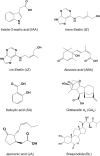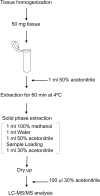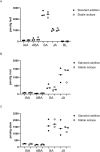Quantitative analysis of seven plant hormones in Lotus japonicus using standard addition method
- PMID: 33600422
- PMCID: PMC7891737
- DOI: 10.1371/journal.pone.0247276
Quantitative analysis of seven plant hormones in Lotus japonicus using standard addition method
Abstract
Plant hormones have been identified to be versatile signaling molecules essential for plant growth, development, and stress response. Their content levels vary depending on the species, and they also change in response to any external stimuli. Thus, simultaneous quantification of multiple plant hormones is required to understand plant physiology. Sensitive and quantitative analysis using liquid chromatography-linked mass spectrometry (LC-MS/MS) has been used in detecting plant hormones; however, quantification without stable isotopes is yet to be established. In this study, we quantified seven representative plant hormones of Lotus japonicus, which is a model legume for standard addition method. Accurate masses for monoisotopic ions of seven phytohormones were determined for high-resolution mass spectrometry (HR-MS). Selected ion monitoring (SIM) mode based on accurate masses was used in detecting phytohormones in the roots, stems, and leaves. Evaluation of matrix effects showed ion suppression ranging from 10.2% to 87.3%. Both stable isotope dilution and standard addition methods were able to detect plant hormones in the roots, stems, and leaves, with no significant differences in using both approaches and thus a standard addition method can be used to quantify phytohormones in L. japonicus. The method will be effective, especially when stable isotopes are not available to correct for matrix effects.
Conflict of interest statement
The authors have declared that no competing interests exist.
Figures



References
Publication types
MeSH terms
Substances
LinkOut - more resources
Full Text Sources
Other Literature Sources
Research Materials

